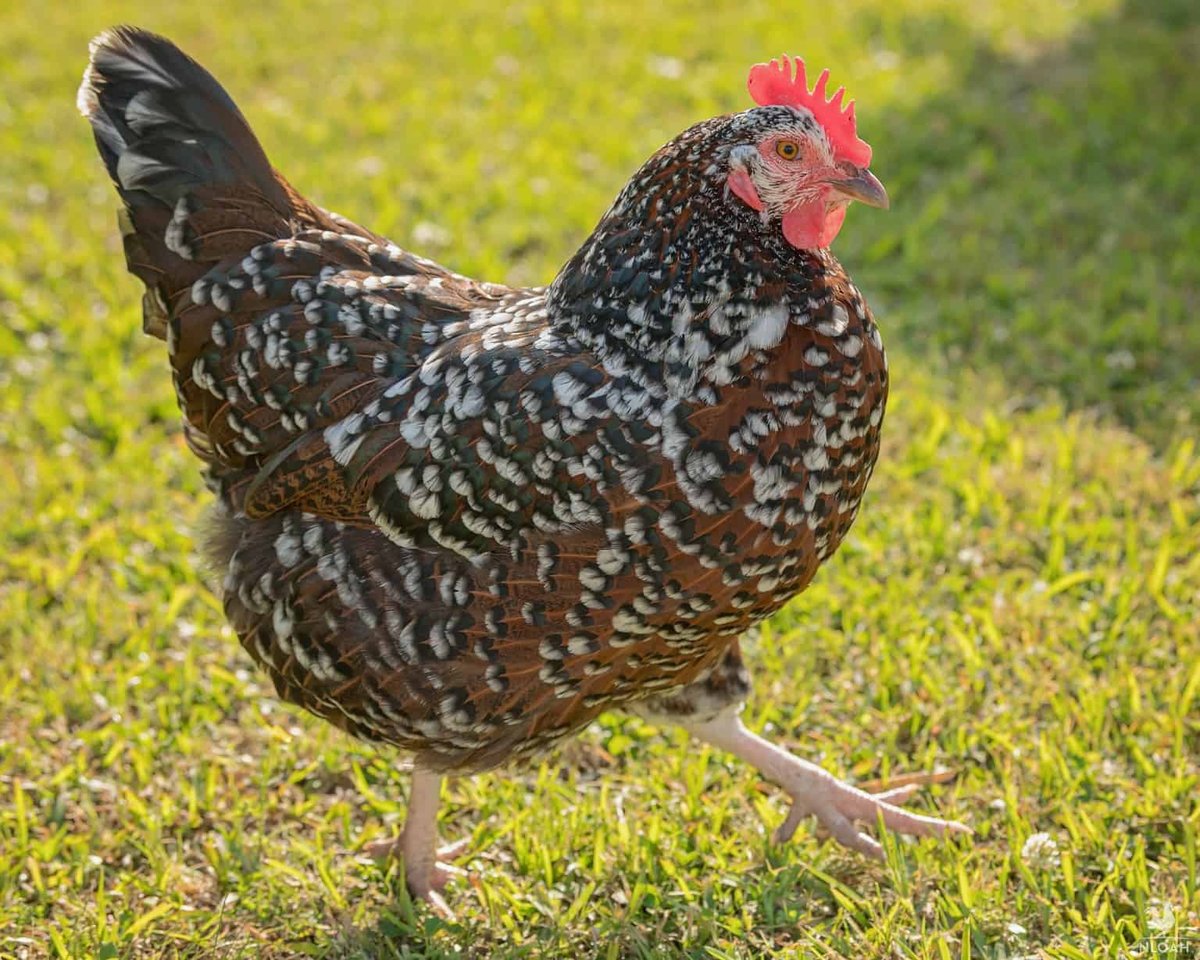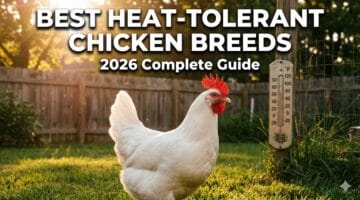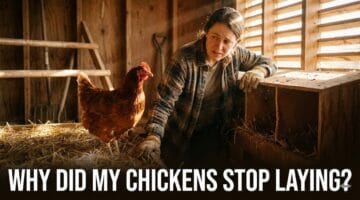If you’re searching for the perfect backyard poultry that combines beauty, personality, and productivity, let me introduce you to the Speckled Sussex chicken. After raising these stunning birds for over eight years, I can confidently say the Speckled Sussex chicken has earned its reputation as one of the most beloved dual-purpose chickens in America.
What makes these mahogany-feathered beauties special? It’s their unique combination of excellent egg production (200-250 eggs annually), friendly temperament, and that gorgeous speckled pattern that becomes more pronounced with each molt. Whether you’re a first-time chicken keeper or expanding your existing backyard flock, Speckled Sussex chickens offer something truly special.
Speckled Sussex Chicken Quick Profile
Here’s a quick look at what makes the Speckled Sussex a top choice for backyard keepers.
- Temperament: Extremely friendly, docile, and curious. Anecdotally, they are often called the “golden retrievers of the chicken world.”
- Purpose: True dual-purpose breed, excellent for both consistent egg and high-quality meat production.
- Egg Production: Lays 200-250 large brown eggs per year, continuing through the winter months.
- Egg Color: Light to medium brown.
- Size: Heavy-bodied, with hens weighing 6-7 lbs and roosters 8-9 lbs.
- Special Traits: Their speckled feather pattern becomes more pronounced with each molt, making them more unique with age. They are also excellent foragers and highly adaptable to different climates.
What is Special About Speckled Sussex Chickens?
Let’s explore the unique characteristics that make this breed a favorite among poultry enthusiasts.
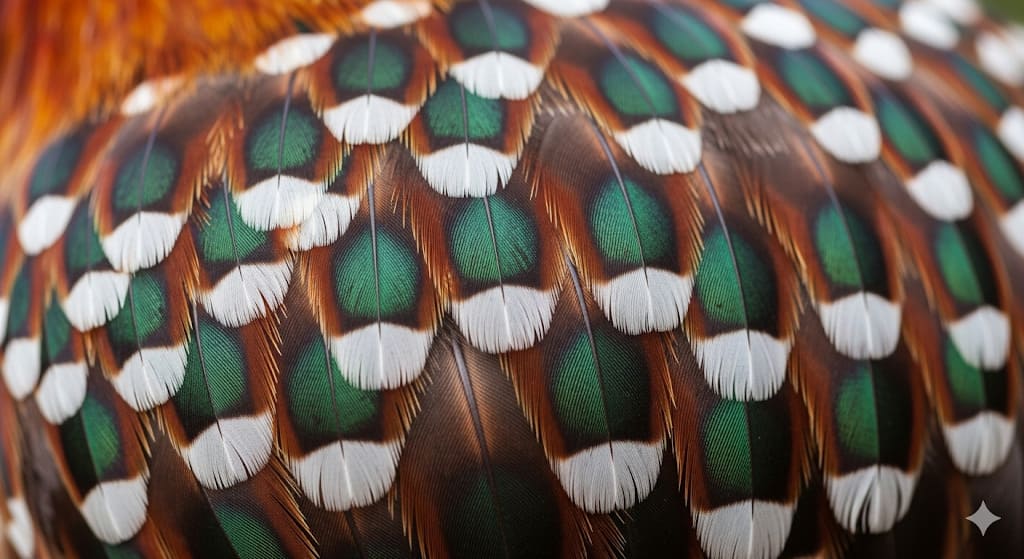
Historical Heritage and Origins
The Sussex chicken traces its roots back to Roman times (43 A.D.) in Sussex County England, making it one of the oldest documented chicken breeds. This remarkable longevity speaks to the breed’s exceptional qualities that have made it invaluable to poultry keepers for over 2,000 years, establishing them as a prominent heritage breed chickens.
The modern Speckled Sussex chicken we know today was developed by Victorian age poultry enthusiasts through selective breeding of Cochin, Dorking, and Malay chickens. This created the perfect dual-purpose chickens that arrived in the United States in 1912. The American Poultry Association recognized the Speckled and Red varieties in 1914, and later recognized the Light Sussex in 1929.
What’s particularly fascinating is the breed’s wartime significance. During World War II, the Sussex and the Rhode Island Red were the primary meat birds in the United Kingdom, demonstrating their reliability and productivity even under challenging conditions. Their role during this time solidified their reputation as a hardy, reliable, and essential breed for food security.
Unique Physical Characteristics
Each Speckled Sussex chicken displays a stunning array of features that make them instantly recognizable. As part of the English class chickens, they are also classified as a heavy breed chicken.
Feather Pattern Evolution:
- Rich mahogany coloring with distinctive white-tipped feathers.
- Red feathers with black bands separating the white tips.
- Greenish-black bars creating a unique speckled pattern.
- No two Speckled Sussex hens are alike in their feather patterning. This individuality makes them easy to distinguish and adds to their charm as members of your flock.
Size and Structure:
- Single, five-pointed red comb. While their cold hardiness is a plus, this type of comb can be susceptible to frostbite in extreme cold. It’s recommended to apply petroleum jelly to the comb and wattles during harsh winters for protection.
- Clean white legs with four toes.
- Heavy body type: Hens typically weigh 6-7 pounds and roosters 8-9 pounds. While these are the standard weights from organizations like the American Poultry Association, it’s worth noting that weights can vary slightly depending on the specific bloodline, diet, and whether the bird is bred for exhibition or backyard utility. This substantial weight is a key characteristic of a dual-purpose breed, meaning they are excellent for both egg and meat production.
- The Poultry Club of Great Britain categorizes the Speckled Sussex chicken as a ‘heavy, soft feather breed’.
Age-Related Changes:
With age and each molt, the white tips multiply, and the birds become more and more speckled. From my personal experience raising them, the oldest hens can look dramatically different from their first-year appearance! This unique “molting magic” is a fun and beautiful feature that makes them an evolving member of your flock.
Their Intelligence and Trainability
Speckled Sussex chickens aren’t just pretty faces; they are known for their remarkable intelligence and ability to learn. They are curious and observant, quickly learning daily routines and responding to their keeper’s call. This makes them highly trainable. With patience and a few mealworm treats, you can teach them to come when called and even follow you around the garden like a loyal pet. Their problem-solving skills, like figuring out how to get to a tasty treat, are a constant source of entertainment.
The combination of ancient heritage, stunning appearance, and proven performance makes the Speckled Sussex truly special. Beyond their striking looks and historical roots, a Speckled Sussex’s personality is what truly sets them apart.
Temperament: The Friendly Garden Companions
Beyond their striking looks, the true charm of a Speckled Sussex chicken lies in their gentle and engaging personality.
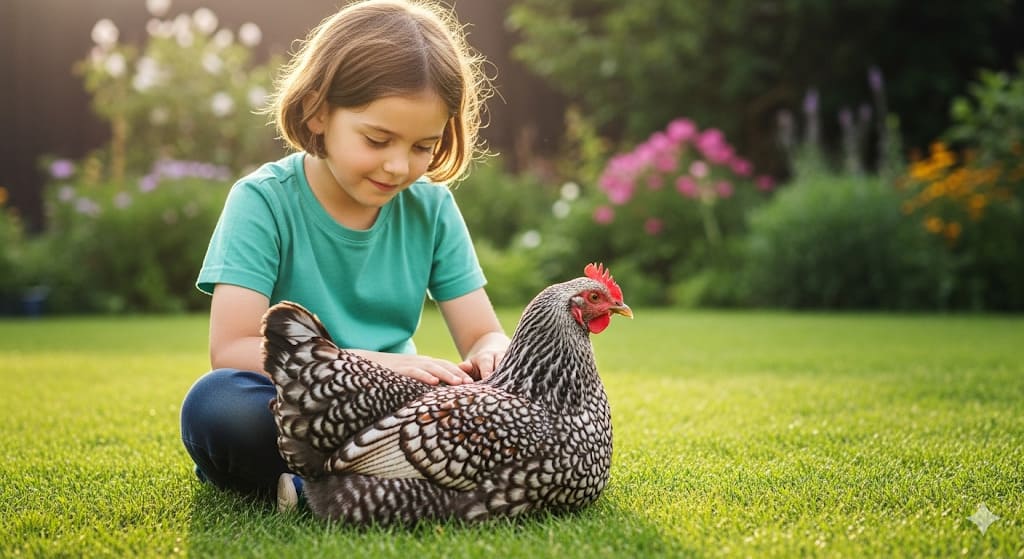
What is the Temperament of Speckled Sussex Chickens?
In my experience, Speckled Sussex chickens are the “golden retrievers of the chicken world.” This breed has a friendly, calm personality, which makes them easy for beginners to handle. Their exceptional temperament sets them apart from many other heritage breed chickens. As the poultry experts at Raising Happy Chickens put it, “If you want the chicken version of a lap-dog, this is the breed for you!”
Core Personality Traits:
- Exceptionally friendly and curious: They are friendly, easy-going, and great with kids! If you bring them treats, they’ll follow you around the yard and become your best friends.
- Calm and docile: Perfect for families with children, as they have the gentle personality needed to introduce young ones to chickens. They are less likely to be flighty or skittish than other breeds.
- Chatty and animated: They love telling me all about their daily adventures. Their soft clucking and happy “warbling” sounds are a soothing addition to any backyard flock.
- Excellent foragers: Speckled Sussex chickens make excellent free-range chickens and will be active, reducing your feed costs while controlling garden pests. They’ll spend hours happily scratching and exploring.
- Cold and heat tolerant: Adaptable to various climates with proper shelter.
Social Dynamics and Flock Integration
They’ll run to greet you in the mornings, sit next to you as you work in your yard, and sing a soothing warbling song when feeling particularly contented.
The Speckled Sussex chicken typically maintains a peaceful position in the pecking order. Although confident, Speckled Sussex chickens aren’t aggressive with other breeds. They are more likely to be a subordinate or middle-of-the-pack hen. It’s wise to observe initial encounters when introducing new chickens to your flock, especially if there are already more aggressive breeds. As one experienced keeper on a Reddit poultry forum noted, “Very personable birds. Very friendly and strong personalities. And very chatty.”
Child-Friendly Characteristics
One of the breed’s standout features is their exceptional compatibility with children:
- They are so calm and trusting that they are perfect for introducing guests to chickens, especially people who have never pet a chicken before.
- They tolerate handling well and rarely show aggression.
- Their curious nature makes them engaging pets for young family members. Children can easily learn how to handle them and enjoy interacting with them without fear of being pecked.
Vocalizations and Communication
Speckled Sussex chickens are a talkative breed, and their diverse vocalizations are part of their charm. You’ll quickly learn to distinguish their different sounds:
- Soft Clucking: A common sound that indicates contentment while foraging or enjoying a dust bath.
- The “Egg Song”: A loud, celebratory, and often sustained series of clucks and squawks that a hen performs after laying an egg.
- Alarm Calls: A sharp, distinct shriek to warn the flock of potential predators.
- The “Warble”: A melodic, purring sound that, in my experience, is unique to the breed and used to show affection or deep contentment. It’s their version of a happy greeting.
Their charming personalities and conversational clucks are just the beginning; what truly makes a Speckled Sussex a top-tier backyard bird is their reliable performance in the coop.
Egg Production Excellence
As a dual-purpose breed, their consistent and reliable Speckled Sussex chicken egg production is a major selling point for any flock owner.
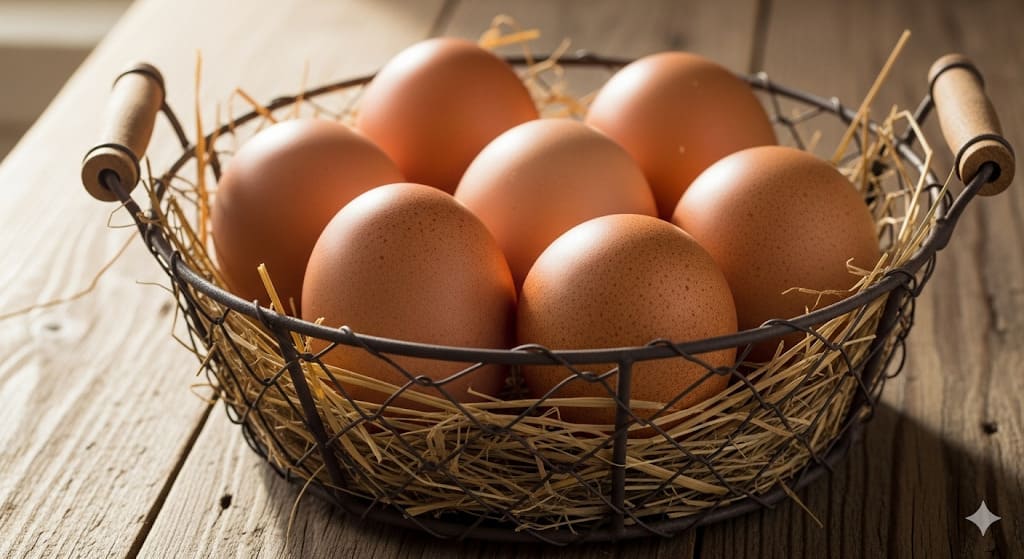
How Many Eggs Do Speckled Sussex Chickens Lay Per Year?
Speckled Sussex hens are reliable layers that consistently deliver for backyard poultry enthusiasts. Speckled Sussex chickens are known for their excellent Speckled Sussex chicken egg production, laying around 200 to 250 large brown eggs per year. This translates to approximately 4-6 Speckled Sussex chicken eggs per week during peak production periods.
Production Timeline:
- Starting Age: Hens begin laying around 16-20 weeks old, which is a fairly early age for a heritage breed.
- Peak Production: Years 1-3 provide maximum output. You’ll get the most consistent Speckled Sussex chicken egg production during this time.
- Consistency: On average, a healthy Speckled Sussex hen can lay around 4 to 5 Speckled Sussex chicken eggs per week, equating to approximately 200 to 250 Speckled Sussex chicken eggs per year.
- Winter Performance: Unlike many breeds, they continue laying through winter months, provided they have enough light and food. Their cold hardiness helps them stay productive when other dual-purpose chickens slow down.
The Molting and Laying Cycle
A key factor to understand about egg production is the molting cycle. Once a year, typically in the fall, your hens will lose their feathers and grow a new coat. This process requires a significant amount of energy and protein, which is why a hen will stop or drastically reduce her egg laying during a molt. This natural cycle is essential for their long-term health and ensures they have a fresh, dense coat of feathers for the winter. It’s also important to remember that laying slows down significantly during the shortest days of winter unless supplemental light is provided in the coop to trick their bodies into thinking it is still spring.
Factors Affecting Egg Production
Several key factors influence laying rates:
Nutritional Impact:
Speckled Sussex chickens might not lay as well if they get too fat. Maintaining proper weight through controlled feeding ensures optimal Speckled Sussex chicken egg production.
Environmental Conditions:
- Adequate sunlight is crucial. Experts suggest at least 14 hours of light to promote ovulation. During shorter winter days, artificial light in the coop can be a beneficial addition.
- Temperature extremes can temporarily reduce laying.
- Stress from predators or flock changes affects output.
Age-Related Changes:
- First-year pullets may start slowly but quickly reach full production.
- Production gradually declines after age 3-4, but they can still lay for many more years, just at a reduced rate.
Speckled Sussex Chicken Egg Color and Characteristics
The Speckled Sussex chicken egg color is a beautiful light to medium brown, a feature prized by many keepers. The eggs from Speckled Sussex chickens are prized for several reasons:
Physical Characteristics:
- Speckled Sussex chicken egg color can vary slightly, but is usually light to medium brown.
- Large-sized Speckled Sussex chicken eggs averaging 2.0-2.3 ounces.
- The Speckled Sussex chicken eggs are considered excellent in quality. The yolks are vibrant and the taste is often described as hearty and delicious.
Quality Factors:
- Excellent for baking due to rich, golden yolks.
- Strong shells indicating good calcium absorption.
- Consistent shape and size throughout the laying season.
- Superior taste compared to commercial eggs.
Maximizing Egg Production
To optimize your Speckled Sussex hens’ laying potential:
Dietary Requirements:
- For hens to produce Speckled Sussex chicken eggs optimally, they require a layer feed that is rich in calcium.
- Provide 16-18% protein layer feed.
- Supplement with oyster shell for calcium.
- Avoid overfeeding to prevent obesity.
Environmental Management:
- Maintain clean, comfortable nesting boxes (one per 3-4 hens).
- Provide 14+ hours of light during winter.
- Minimize stress through consistent routines.
- Ensure adequate ventilation in coops.
The Speckled Sussex’s reliable Speckled Sussex chicken egg production, combined with excellent egg quality, makes them a top choice for backyard poultry. Their ability to maintain laying through winter sets them apart from many other breeds. Now that we’ve covered their impressive egg production, it’s time to delve into the comprehensive care that will keep your flock happy, healthy, and productive for years to come.
What Does Baby Speckled Sussex Look Like?
When they first hatch, baby Speckled Sussex chickens have a distinctive appearance that is different from their adult plumage. Their coloring is a combination of brown and black markings, and they have clean white legs and feet. The brown striping that runs down their back and head is particularly noticeable. This chick down will eventually be replaced by their signature mahogany coloring and speckled pattern as they mature.
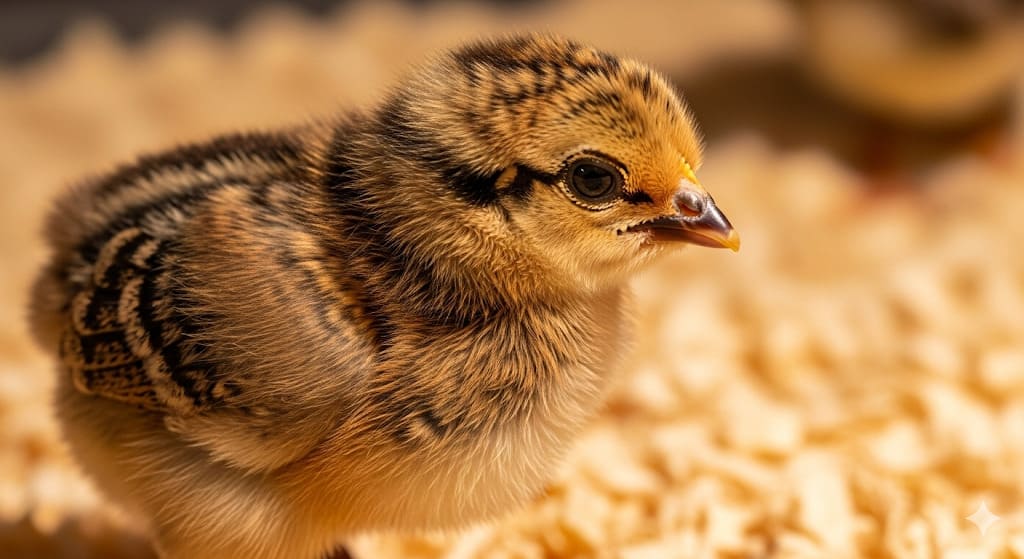
Do Speckled Sussex Chickens Fly?
Due to their classification as a heavy breed chicken, Speckled Sussex chickens are typically not known for being strong fliers. While they can manage short flights and hop up onto a roost or a low fence, their substantial weight and large bodies prevent them from flying long distances or to significant heights. This characteristic makes them easier to contain in a backyard flock and means you generally don’t have to worry about them flying out of their coop or run. For this reason, many keepers can use low fencing to safely contain their flock.
What Chicken Lays Blue Eggs?
If you are looking for chickens that lay blue eggs, it’s important to know that Speckled Sussex chickens do not. As a heritage breed chicken, they are a reliable source of beautiful light to medium brown eggs. Blue eggs are a trait of specific breeds, such as the Ameraucana, Araucana, and Cream Legbar. These breeds possess a gene that causes a blue pigment to be deposited on the eggshell.
Complete Care Guide
Caring for Speckled Sussex chickens is straightforward, making them an excellent choice for novice and experienced keepers alike.
How to Care for Speckled Sussex Chickens?
Caring for Speckled Sussex chickens is straightforward, but attention to detail ensures healthy, productive birds. Their hardy nature makes them forgiving of minor mistakes, perfect for beginners.
Housing Requirements
Space Specifications:
- Each Speckled Sussex chicken should have at least 4 square feet of chicken coop space and 10 square feet per bird in outdoor runs.
- Regarding perch space, allocating 8 to 10 inches per chicken is advisable.
- For nesting, a standard 12×12 inch box works well, with a ratio of one nesting boxes for every three hens.
Coop Design Considerations:
- The coop should be well-ventilated, dry, and free from drafts.
- Install roost bars at least 10 inches wide to accommodate their heavy bodies.
- Use the deep litter method for easier maintenance. This involves adding a fresh layer of carbon-rich material (like pine shavings) to the coop floor periodically, allowing droppings to compost into a rich fertilizer that also provides insulation.
- Predator Protection:
- Secure all openings with hardware cloth (not chicken wire).
- Protect them from predators like foxes, hawks, raccoons, or dogs using fences, nets, locks, or alarms.
- Install automatic door closers for consistent security.
Common Coop Mistakes to Avoid
Even experienced keepers can make these simple errors. By avoiding them, you’ll ensure a safer and healthier environment for your flock.
- Overcrowding: This leads to stress, feather picking, and disease spread.
- Using Chicken Wire: Chicken wire is only designed to keep chickens in, not predators out. Raccoons and other pests can easily tear through it. Always use strong, welded wire hardware cloth.
- Poor Ventilation: Ammonia fumes can build up and cause respiratory illness. Ensure your coop has high vents to allow hot, stale air to escape, but without creating a draft directly on the roosting chickens.
- Neglecting a Dust Bath Area: Dust bathing is essential for a chicken’s hygiene. Provide a dry area with sand or soil mixed with a bit of diatomaceous earth to help them naturally ward off external parasites.
Nutrition and Feeding Guidelines
Basic Dietary Requirements:
As a dual-purpose breed with a long history as a table fowl, Sussex chickens require a higher protein percentage in their feed to grow and lay well.
Age-Specific Feeding:
- Chicks (0-8 weeks): 22% protein feed. Some breeders use 24% Gamebird Starter.
- Growers (8-16 weeks): 18-20% protein grower feed.
- Layers (16+ weeks): 16-18% protein layer feed with a calcium supplement.
Daily Consumption:
A Speckled Sussex chicken should be given approximately 1/4 to 1/3 of a pound of feed per day. This amount can be adjusted based on their foraging activity and body condition.
Safe and Unsafe Treats:
Treats are a fun way to interact with your flock but should make up no more than 10% of their total diet. Safe treats include leafy greens, corn, berries, cooked oatmeal, and mealworms. Avoid giving them raw potatoes, avocados, chocolate, citrus fruits, and anything with a high salt or sugar content.
With proper care and housing in place, you’re well on your way to a happy flock. Next, let’s explore the other side of this dual-purpose breed—their excellent qualities as a meat bird.
Regional Climate Adaptations
While English class chickens like the Speckled Sussex are remarkably adaptable, their single combs and heavy bodies mean you should make some specific modifications to their housing for extreme climates to keep them safe and productive.
For Extreme Cold:
- Insulation: Add insulation to the coop walls, floor, and ceiling to help hold heat in.
- Roosting Bars: Use wider, flat roosting bars (at least 2×4 with the wider side facing up) to allow chickens to cover their feet with their feathers while sleeping, preventing frostbite.
- Heated Waterer: Use a heated waterer to prevent water from freezing, as chickens can’t drink frozen water.
- Deep Litter Method: Ensure the deep litter on the coop floor is maintained. The decomposition of the bedding will generate a small amount of heat, which can help keep the coop warmer.
- Comb Protection: As mentioned previously, applying petroleum jelly to their combs and wattles on very cold nights is crucial to prevent frostbite.
For Extreme Heat:
- Increased Ventilation: Add more vents, especially at the top of the coop, to create a chimney effect that pulls hot air out. Consider adding a small, battery-operated fan to improve air circulation.
- Shade and Water: Ensure there is ample shade in the run, and provide multiple large water sources. Add ice cubes to their water to help them stay cool throughout the day.
- Frozen Treats: Offer frozen treats like frozen corn, watermelon, or berry-water ice cubes to help them stay cool.
- Dust Bath in Shade: Make sure their dust bath area is in a cool, shaded spot. Dust bathing helps them regulate their body temperature.
Seasonal Care Calendar
To help you give your flock the best care all year round, here is a month-by-month calendar with actionable tips to keep your heavy breed chickens happy and healthy.
Spring Care (March – May)
- Breeding Season: This is the prime time for breeding. If you have a rooster and want to hatch chicks, this is when you can set up a broody hen or an incubator.
- Chick Care: If you’re getting new chicks from a hatchery, prepare your brooder box with a heat lamp, feeder, and waterer.
- Foraging: As plants emerge, allow your chickens to free-range more. This will provide them with fresh greens and insects, supplementing their diet and reducing your feed costs.
Summer Care (June – August)
- Hydration: Ensure a constant supply of fresh, cool water, with multiple waterers if needed.
- Heat Management: Provide plenty of shade and ventilation in the coop. You can also offer frozen treats like frozen corn or fruit to help them cool down. Avoid overfeeding in hot weather.
- Egg Production: Egg production should be at its peak during the long summer days. Continue to provide a quality layer feed and calcium supplements.
Fall Care (September – November)
- Molting Season: The shorter days of fall trigger the annual molt. Your chickens will stop or slow down laying to conserve energy for growing new feathers.
- Feed Adjustments: Increase their protein intake to support feather growth. You can switch to a higher-protein feed or supplement with high-protein treats like black oil sunflower seeds or mealworms.
- Coop Preparation: Prepare the coop for the coming winter. Check for drafts, make any necessary repairs, and ensure the roof is leak-proof.
Winter Care (December – February)
- Comb Protection: Their single combs are susceptible to frostbite. Apply a thin layer of petroleum jelly to the combs and wattles on very cold nights for protection.
- Feed and Water: Provide extra food in the evening to give them energy to stay warm overnight. Keep water from freezing with a heated waterer or by changing it frequently.
- Egg Production: Laying will slow down naturally. If you want to encourage winter laying, you can add supplemental light to the coop to maintain at least 14 hours of light.
Meat Production Qualities
While they are known for their eggs, their historical role as a top-tier table fowl makes them a truly valuable dual-purpose breed.
Are Speckled Sussex Chickens Good for Meat?
Bred in the mid-1800s in Sussex, England, the breed was initially developed as a meat bird. Before Cornish Rocks gained popularity, the Sussex was the primary meat bird of England. This heritage as a premier table fowl continues to make them an excellent choice for sustainable meat production. As an English class chicken, it is important to note that heritage breeds like the Sussex take significantly longer to mature for meat production (around 20 weeks) compared to commercial broiler chickens (6-8 weeks), which affects their economic viability for large-scale pure meat production. As the Livestock Conservancy notes, the Sussex chicken is a “good all-around table bird, famous for flavor.”
Processing Specifications:
- Weight and Timing: Dressed weight is 6-7 pounds for hens and 8-10 pounds for roosters. The optimal processing age for optimal tenderness is around 20 weeks, which is a standard timeline for many heritage breeds.
- Meat Characteristics: The meat is incredibly tender, especially when young, with a rich, traditional chicken flavor. It has a slightly finer texture and more robust taste than commercial broiler breeds.
Raising for Meat
Optimal Growth Strategies:
They need to be raised with a higher protein percentage in their feed. 16% or 18% or even 21% will not do. Start with 22-24% protein starter feed.
Processing Considerations:
Home processing is feasible due to their moderate size, and they provide a good yield.
Their dual-purpose breed nature makes them a valuable addition to any homestead, and their strong maternal instincts further solidify their role as a truly self-sufficient breed.
Breeding and Broody Behavior
Their natural maternal instincts are a hallmark of the breed, making them excellent mothers for hatching and raising chicks.
Do Sussex Chickens Go Broody?
Yes, Speckled Sussex hens often display strong maternal instincts, which makes them great brooders for keepers who want chicks hatched and raised naturally. This natural tendency sets them apart from many modern production breeds. They are known for their strong tendencies as broody hens.
Broody Characteristics:
- Frequency: They have a moderate to high broodiness tendency and are most likely to go broody in the spring/early summer. Some broody hens may go broody 2-3 times per year.
- Maternal Behaviors: They are dedicated sitters who rarely leave the nest and are fierce protectors of their eggs and chicks. They will also teach their chicks everything they need to know.
Managing Broody Hens
Encouraging Broodiness:
Provide quiet, darkened nesting boxes and leave fake eggs to stimulate sitting.
Breaking Broodiness:
To break broodiness, remove the hen from the nesting boxes, provide a cool environment, and ensure she has access to food and water. You can also place her in a “broody breaker” cage with a wire bottom for a day or two to disrupt her nesting instinct.
Hatching and Rearing Chicks
If you have a broody hen, you have a natural incubator and a dedicated mother. The process is simple:
Hatching:
Once your hen has settled on a clutch of eggs, leave her be. She will handle all the turning and temperature regulation.
Brooding:
After the eggs hatch, the hen will raise the chicks herself. She will teach them to eat, drink, and stay warm under her feathers.
Brooder Setup:
For chicks purchased from a hatchery, you’ll need to create a brooder box with a heat lamp, chick feed, and water. A brooder is a safe, warm space where chicks can live for the first 4-6 weeks until they are feathered out. Here is a guide on what to get when bringing chicks home.
Breeding Program Considerations
Genetic Selection:
Proper breeding requires attention to standard characteristics and a focus on maintaining the breed’s unique genetics. Breeders should focus on birds with the correct feather coloring and the desired speckling pattern.
Breeding Goals:
The goal is to breed birds with tight, even, well-distributed triangular spangles.
How to Tell if a Speckled Sussex is Male or Female?
Chick Sexing:
Not sex-linked, making early identification challenging.
Juvenile Indicators (8-12 weeks):
Males will develop larger, redder combs and pointed saddle and hackle feathers. Females will have rounded feather tips.
Adult Characteristics:
Roosters usually weigh more, have prominent spurs, a large comb and wattles, and distinctive curved tail feathers. Hens weigh slightly less and have smaller features.
Whether you hatch your own or buy from a hatchery, knowing where and how to find healthy birds is the final step in starting your Speckled Sussex chicken journey.
Purchasing Guide
Before you bring home your new flock members, it’s essential to know how to find healthy, high-quality birds from a reliable source.
Where to Buy Speckled Sussex Chickens?
Finding quality Speckled Sussex chickens requires research and careful selection of reputable sources. It’s best to buy from a reputable breeder. There are a lot of chickens out there described as a specific breed when they’re actually a hybrid.
Reputable Sources:
- Major Hatcheries: Meyer Hatchery, Cackle Hatchery, Murray McMurray Hatchery, and Ideal Poultry.
- Local Options: Regional poultry associations, farm stores, and local breeders.
How Much Do Speckled Sussex Chickens Cost?
Current Market Pricing (2025):
- Day-old chicks: $5-9 each (straight run).
- Sexed pullets: $7-12 each.
- Started pullets: $25-40 each.
- Adult hens: $40-65 each.
- Quality roosters: $30-45 each.
Factors Affecting Price:
- Age and Sex: Sexed pullets cost more than straight run.
- Season: Spring prices are typically higher due to demand.
- Quality: Show-quality birds command premium prices.
- Seasonal Fluctuations: Prices tend to be highest in the spring, during the peak of “chick season,” and may decrease slightly in the fall and winter.
- Regional Variations: Prices can be lower in rural areas with more local breeders and higher in urban or suburban areas where demand is higher and supply is limited. Online hatcheries may offer more competitive prices, but shipping costs need to be factored in.
Checklist for Healthy Chickens
When you are ready to bring new birds home, whether from a hatchery or a local breeder, look for these signs of a healthy Speckled Sussex chicken:
- Alert and Active: The chick or hen should be lively and curious, not lethargic or huddled in a corner.
- Bright, Clear Eyes: Eyes should be free of crust, foam, or discharge.
- Clean Vent: The area around the vent (where droppings exit) should be clean and free of pasted-on feces, which is a sign of “pasty butt” or other digestive issues.
- Steady on Their Feet: The bird should walk and stand without a wobble or limp.
- No Respiratory Issues: Listen for any sneezing, wheezing, or gurgling sounds, which indicate a respiratory infection.
- No External Parasites: Check for mites, lice, or fleas on the skin under the feathers.
With all this knowledge, you’re ready to make an informed decision and welcome this wonderful breed into your life. Now, let’s take one last look at why this breed stands out above the rest.
Cost-Benefit Analysis: The Economics of a Speckled Sussex Flock
Before you start your flock, it’s wise to consider the economic side of chicken keeping. While it’s more of a rewarding hobby than a true business, keeping Speckled Sussex chickens can significantly reduce your grocery bill and provide a sustainable source of food. Let’s break down the typical annual costs versus the value of a small, four-hen flock.
Annual Costs
These are the recurring expenses after your initial investment in a coop, feeders, and the birds themselves.
Feed:
A Speckled Sussex eats about $0.25 worth of feed per day. For a flock of four hens, that’s $1.00 per day, or approximately $365 per year. This is the biggest expense.
Bedding & Supplements:
Pine shavings for the coop and occasional treats and grit. We can estimate this to be around $50 per year.
Miscellaneous:
This includes things like health checks, cleaning supplies, and any small repairs. This is a low-cost category, let’s budget around $20 per year.
Total Annual Cost (4-hen flock): ~$435
Annual Value
The value of your flock isn’t just in the delicious food they produce; it’s in the savings you get from not buying eggs and meat at the store.
Egg Value:
A healthy Speckled Sussex hen will lay about 225 eggs per year. A flock of four hens will produce approximately 900 eggs, or about 75 dozen. At a conservative market price of $5 per dozen for quality eggs, that’s a value of $375 per year.
Meat Value:
If you raise a single rooster to maturity (around 20 weeks) for meat, he will provide about 7 pounds of high-quality meat. At an average price of $5 per pound for free-range meat, this is an additional value of $35.
Total Annual Value (4-hen flock + 1 rooster): ~$410
The Bottom Line
Based on these estimates, a small flock of four hens and one rooster has an annual value of roughly $410 against a cost of $435, resulting in a net cost of about $25 per year.
This shows that while it may not be a profitable business venture, the economic value of keeping Speckled Sussex chickens is incredibly close to the annual costs. The real benefit comes from knowing exactly where your food comes from, enjoying superior-tasting eggs and meat, and the immense satisfaction of a rewarding hobby.
Speckled Sussex vs. Other Dual-Purpose Breeds
To help you decide if the Speckled Sussex is the right fit, here is a comparison of its key traits against three other popular dual-purpose breeds.
| Feature | Speckled Sussex | Rhode Island Red | Plymouth Rock | Orpington |
|---|---|---|---|---|
| Egg Production | Good (200-250 large brown eggs/year) | Excellent (250-300 large brown eggs/year) | Good (200-250 large brown eggs/year) | Fair (150-200 large light brown eggs/year) |
| Temperament | Calm, very friendly, curious, and great with kids. | Active, can be assertive or “bossy,” less docile than Sussex. | Docile, calm, and friendly. Excellent all-around backyard birds. | Extremely docile, gentle, and non-aggressive. Known for being “fluffy teddy bears.” |
| Cold Hardiness | Very cold hardy, but their single comb requires protection from frostbite. | Very cold hardy. | Very cold hardy, known for thriving in cold climates. | Good cold hardiness due to dense feathering, but can overheat in hot weather. |
Frequently Asked Questions
How many eggs do Speckled Sussex chickens lay?
Speckled Sussex hens are excellent layers, producing between 200 and 250 large, brown eggs per year. They are also known for being reliable winter layers, often continuing to lay when other breeds have stopped for the season.
Are Speckled Sussex chickens good for families with kids?
Yes, absolutely. They are considered one of the best breeds for families due to their exceptionally calm, friendly, and curious nature. They tolerate handling well and are not typically aggressive, making them wonderful and engaging pets for children.
Do Speckled Sussex chickens fly?
No, not well. As a heavy breed chicken, Speckled Sussex are poor fliers. Their weight prevents them from flying high or far, which makes them very easy to contain in a backyard with standard-height fencing.
Are Speckled Sussex good for meat?
Yes, they are an excellent meat breed. Historically, they were one of England’s premier table birds before the rise of modern broilers. They have a good meat-to-bone ratio and are known for their flavorful, tender meat, making them a true dual-purpose choice.
What is the lifespan of a Speckled Sussex chicken?
A healthy, well-cared-for Speckled Sussex chicken typically has a lifespan of 5 to 8 years. Their most productive egg-laying years are the first three, but they will continue to be a cherished part of the flock for many years after.
Do Speckled Sussex chickens go broody?
Yes, they have a strong tendency to go broody, especially in the spring and summer. This makes them fantastic mothers if you want to hatch your own chicks naturally. If you don’t, their broodiness can be managed with a few simple techniques.
Are Speckled Sussex good for beginners?
They are a perfect choice for beginners. Their forgiving nature, docile temperament, natural foraging skills, and general hardiness make them one of the easiest and most rewarding breeds for a first-time chicken keeper.
Final Recommendations
With their perfect balance of beauty and productivity, the Speckled Sussex chicken is a top-tier choice for any backyard.
Why Choose Speckled Sussex Chickens?
After years of experience with various breeds, in my personal opinion, I consistently recommend Speckled Sussex chickens for their unmatched combination of beauty, productivity, and personality. People have discovered that this heritage breed chicken has a lot going for it! This is why heritage breed chickens are experiencing a resurgence in popularity, being discovered by a whole new group of chicken keepers. As Rhonda, a long-time keeper for Backyard Poultry, concludes, “If not, I hope you’ll consider this breed as an addition to your backyard flock.”
Ideal For:
- Beginning Chicken Keepers: They are forgiving of minor husbandry mistakes and, with their easy-going temperament, are a perfect breed for any new backyard poultry enthusiast just starting out.
- Family Flocks: If you’re looking for a striking-looking chicken who is also an excellent companion, good egg layer, and curious friend for children or grandchildren, the Speckled Sussex chicken could be your perfect breed.
- Sustainable Homesteads: They have true dual-purpose breed capabilities, natural reproduction abilities, and excellent foraging skills that reduce feed costs.
- Mixed Flocks: They integrate peacefully with other breeds, are non-aggressive to smaller birds, and add a beautiful diversity to your flock.
Longevity and Lifespan
An important consideration for any prospective chicken owner is the long-term commitment. Speckled Sussex chickens typically have a lifespan of 5-8 years, making them a wonderful, long-term addition to your family. While their peak egg production years are generally the first three, they will continue to lay at a reduced rate for many years, all while providing companionship and beauty to your backyard. This longevity is a key trait of a well-bred heritage chicken, and it is a major factor in their value.
Investment Value:
Long-term Benefits:
- Production Longevity: 3-4 years of strong egg laying.
- Meat Value: Quality table birds at the end of their laying career.
- Breeding Potential: Valuable genetics for heritage programs.
- Low Maintenance: A hardy constitution reduces veterinary costs.
- Feed Efficiency: Excellent foragers supplement their diet.
Economic Considerations:
- Initial cost is recovered within the first year through egg production.
- Reduced feed costs through foraging.
- Natural chick production eliminates replacement costs.
Success Tips for New Owners:
First Year Priorities:
Establish routines, monitor weight, socialize early, and track changes.
Common Mistakes to Avoid:
Overfeeding, inadequate roost space, ignoring early broodiness signs, and expecting immediate high production.
The Heritage Difference:
This is great news for such an unassuming chicken whose ancestors hung around with the Romans! Choosing Speckled Sussex means:
- Preserving agricultural heritage.
- Supporting genetic diversity.
- Maintaining sustainable traits.
- Connecting with history.
- Building resilient flocks.
Final Thoughts:
The Speckled Sussex chicken is a wonderful choice for any backyard, combining reliable egg production, excellent meat quality, and an outstandingly friendly temperament. Their beautiful, ever-changing plumage and historical significance make them more than just productive birds—they are a rewarding, engaging addition to any family flock. With their adaptable nature and peaceful demeanor, they are a joy to raise and a true asset to the modern homestead.

Oladepo Babatunde is the founder of ChickenStarter.com. He is a backyard chicken keeper and educator who specializes in helping beginners raise healthy flocks, particularly in warm climates. His expertise comes from years of hands-on experience building coops, treating common chicken ailments, and solving flock management issues. His own happy hens are a testament to his methods, laying 25-30 eggs weekly.
